In Western music, you’ll most often see music written in pretty straightforward time signatures, such as 4/4, 3/4, 6/8, or 2/2. This is especially prevalent in genres such as blues, rock, pop, folk, and country.
All these styles are typically built on common rhythms that are made up of quarter notes, 8th notes, 16th notes, and so on.
Things get more interesting as you look at genres such as jazz and metal, and especially at music from Africa and India. This music often has rhythms that are much more elaborate, incorporating polyrhythms and syncopation for more complex (and in some cases, very danceable!) drum beats.
So how do we play, write, and internalize these rhythms?
In this guide to polyrhythms for beginners, we’ll introduce you to the concept of polyrhythms, provide you with examples of this rhythmic complexity, and share some techniques for counting and feeling polyrhythms.
By the end of this article, you’ll understand what makes a polyrhythm, how to count them, and how you can practice them on your instrument. You’ll also be able to clap out the two most common polyrhythms, and recognize them in music. And best of all, you’ll have gotten a taste of the endless possibilities that polyrhythms can give music – and will be equipped with ideas of how you can apply this new knowledge to your own songwriting.
Table of Contents
1. What is a polyrhythm?
2. Where are polyrhythms used?
3. How do we define a polyrhythm?
4. How to Count a Polyrhythm
5. How to Practice Polyrhythms
6. Beyond the Basics
What is a polyrhythm?
Simply put, a polyrhythm consists of layers of simpler rhythms. More than one type of rhythm is played at the same time, with each rhythm containing a different beat subdivision.
The rhythmic tension and release found in polyrhythms makes them danceable, aurally interesting, and more expressive than your typical four-on-the-floor rhythm.
In Western music, the typical rhythm has a marked emphasis on beat one, and every other beat in the bar is considered a secondary beat. When rhythms are layered one atop the other, the pattern of emphasis shifts in different ways, giving polyrhythms a distinct feel – these rhythms have more “fill” and are often more complex than those found in traditional Western music.
Take a listen to Mongo Santamaria’s rendition of “Afro Blue”:
Once you tune your ears to polyrhythms, you’ll notice that it’s possible to count the meter differently for different instruments – the multiple percussion instruments overlap and interweave beautifully to form a complex, cohesive rhythm.
That rhythm you hear right at the beginning of the song is a polyrhythm in itself, and probably sounds quite familiar, as a lot of Afro-cuban music makes use of a polyrhythmic djembe beat to form the backbone of the song. Think about this: when’s the last time you heard a straightforward 4/4 rhythm played on African drums?
Let’s look at some other genres that make use of these intricate rhythmic patterns.
When and where are polyrhythms used?
Presently, you’ll find these intricate rhythms in Indian music, Afro-Cuban music, jazz, hip hop, metal, and even some popular music. However, these rhythms can be traced back to a point of origin…
African Origins
Most polyrhythms that we hear today originated in the musical traditions of Africa, with highly danceable rhythms played on traditional percussion instruments. The organic, complex rhythms served an important social purpose in African culture: they are a musical symbol of the rich relationships between individuals that combine to build the cohesive cultural expression of a community.
Polyrhythms provide a perfect way to musically tell stories on many levels – a rhythmic tradition that has continued and evolved in subsequent styles of African and African-American music.
Watch famed African drummer Babatunde Olatunji demonstrate the Liberian Fanga rhythm:
Note the rhythmic complexity – there is a polyrhythm both within the main djembe rhythm, and between all the instruments being played.
The importance of this rhythmic sensibility can’t be overstated. In fact, the influence of African polyrhythmic drumming has even extended into the present-day dancefloor! Okay Africa details how today’s club music owes its dues to African drumming traditions in a fascinating interview with filmmaker Crudo Volta.
Polyrhythm in Jazz
Jazz was one of the first Western music traditions to embrace polyrhythms, taking cues from African drumming and singing traditions and blending it with Western music sensibilities.
Listen to Avishai Cohen’s “Pinzin Kinzin”, taking note of how the piano, bass, and drums play off of each other to achieve a robust overall rhythm:
If you’re a jazz musician itching to get the basics of polyrhythm down, LearnJazzStandards has excellent beginner exercises with 3:2 polyrhythms for you to sink your teeth into.
Polyrhythm in Rock and Metal
As rock ‘n’ roll spawned genres such as industrial, progressive rock, and experimental/art rock, there arose a tendency to play with rhythm and time signatures. As a result, a great number of artists have experimented with writing music with complex fills, unusual rhythmic patterns, and multiple simultaneous meters.
Nine Inch Nails’ Trent Reznor is known for his sonic experimentation, and makes good use of noise, distortion, dissonance, and – you guessed it – polyrhythms. Listen to one of NIN’s more soothing tracks, appropriately entitled “La Mer”, and see if you can spot the polyrhythm:
At [1:22], the drums kick in, playing four beats against the three beats of the piano.
The Hemiola
One of the most common polyrhythmic motifs found in music is the hemiola:
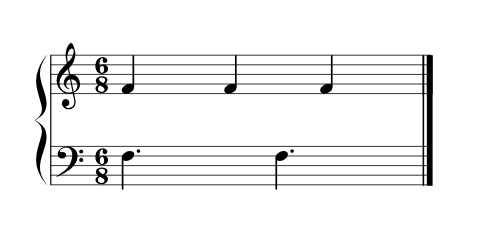
The hemiola is simply three beats with equal value spaced across two beats – in other words, three notes are superimposed onto two. This polyrhythm is found in African music, where it often repeats across the whole song and is referred to as a cross rhythm, or a systematic rhythm that is the base of a piece.
Interestingly, it is also found in Western music, with baroque music making use of the hemiola to surprise the listener and play around with rhythm. David Kulma explains the hemiola using Handel’s famous “Water Music Suite in D Major”:
Essentially, the hemiola surprises the ear by playing with different groupings of a bar of six beats, resulting in a piece of music being felt in two rhythms simultaneously. You can see why it’s one of the most brilliantly simple polyrhythms out there.
How Do We Define A Polyrhythm?
Before we get into playing and counting out polyrhythms, let’s have a look at how they’re constructed.
The Polyrhythmic Formula
Polyrhythms are defined in three ways:
- X over Y
- X against Y
- X:Y
All three mean the same thing, and are used interchangeably. For example, the hemiola polyrhythm discussed above is a 3 over 2 or 3:2 polyrhythm.
Let’s look at what these numbers mean, taking the simple 3:2 polyrhythm as an example.
Generally, Y is the basic pulse, over which the counter rhythm will be played, and X is the counter rhythm.
Therefore in 3:2, X = 3 and Y = 2. The polyrhythm will be played over two beats, with three evenly spaced beats played on top of those two beats – this is also known as triplets over duplets:

Remember that the triplets and duplets take up the same amount of time, so that the first notes in each individual rhythm will sound together. Naturally, this means that the triplets will be played faster than the duplets, in order to arrive on beat one at the same time.
For a more in-depth look at the 3:2 polyrhythm and how to hear it, check out Greg Dyke’s excellent primer.
Let’s look at another polyrhythm, the 4 against 3 polyrhythm:
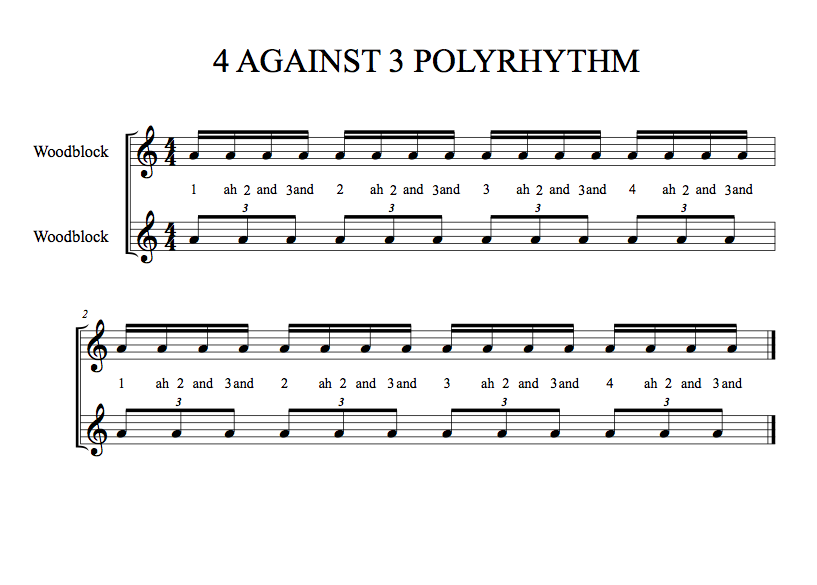
Here, X is 3, and Y is 4. Therefore, the polyrhythm will be played over four beats, with three evenly spaced beats played overtop. As in the previous example, the only time the beats line up is on beat one.
What is and isn’t a Polyrhythm?
Polyrhythms give the impression of one beat being superimposed onto another, causing conflict. Again, a basic example is the 3:2 polyrhythm, where triplets are played over duplets:

Typically, two rhythms will only be considered a polyrhythm if they have no common divisor other than 1. In the case of a 3:2 polyrhythm, there is no number (besides 1) that will divide into both 2 and 3. We can conclude that 3:2 is, in fact, a polyrhythm.
However, if in the same rhythm the 8th notes are replaced with quarter notes, it ceases to be a polyrhythm. This is because there are no longer contrasting beats. Though it may feel like you are playing in two different times, you are not:

Try out the following short exercise! Determine whether each example is considered a polyrhythm or not using the simple rule above:
1) 5:4
2) 4:1
3) 2:5
4) 3:7
Show answer
- Polyrhythm
- Not a polyrhythm
- Polyrhythm
- Polyrhythm
Counting Polyrhythms
The conventional counting method involves using “ah” and “and” to count out loud. For example, to count 8th notes in 4/4 time, we would use 1-and-2-and-3-and-4-and. Similarly, counting 16th notes in 4/4 time would expand to 1-e-and-a-2-e-and-a-3-e-and-a-4-e-and-a.
We can tweak this counting method to fit even the most complex polyrhythms.
However, there is a shortcut for playing the simpler polyrhythms out there… Since so many polyrhythms sound like speech, why not start there?
Polyrhythm Phrasing
Many of the simpler polyrhythms mimic the phrasing of simple, short sentences. Therefore, a method that beginners may find easier and more comfortable is associating a polyrhythm with a phrase that fits with the beat. For example, you can use the phrase “Hot Cup of Tea” to practice 3:2 polyrhythms:

For some variations on the 3:2 polyrhythm and how to play them on the drums, check out Niels Myrner’s exercises.
The slightly trickier 4:3 polyrhythm can be remembered with the phrase “What Atrocious Weather”, as follows:
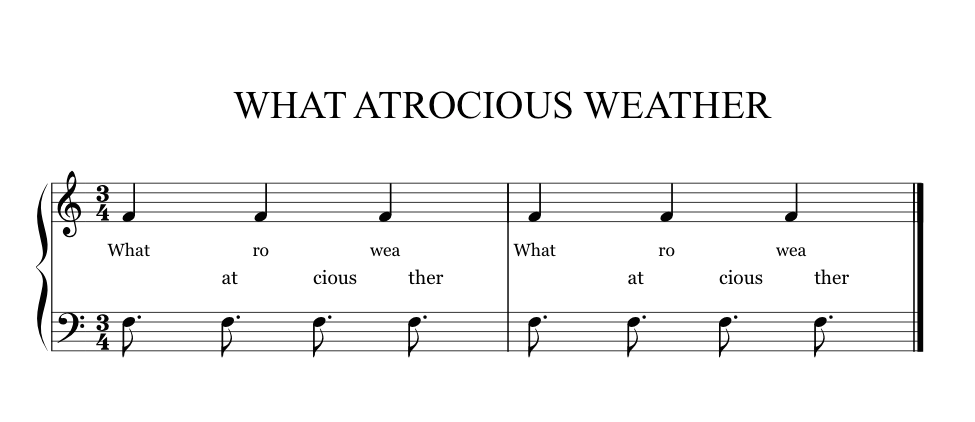
The 3:2 and 4:3 rhythms are fairly straightforward once you get the hang of them. Try playing along with Daily Drum Lesson’s video tutorial.
Complex Counting
As your polyrhythms get wonkier and more complex, it’s harder to find a phrase to fit the rhythm.
This is where some simple math comes in handy. Bear with us, as this little trick will help you count and play even the most bewildering rhythms…
The Lowest Common Multiple
The lowest common multiple (LCM) is simply the lowest number that two (or more) numbers can fit evenly into. We can figure out exactly how to count a polyrhythm by finding the LCM of the two numbers X and Y.
Let’s look at the polyrhythm 3:4 as an example. The LCM is 12, meaning that 12 beats represent a full “cycle” of the polyrhythm – it takes 12 beats for the beat to “align” again.
Let’s lay out this polyrhythm in terms of a grid, split into 12 beats:

As you can see, the beats are evenly spaced in both the “4” rhythm and the “3” rhythm, and the only time the beats occur simultaneously is right at the beginning – on beat one.
Let’s try a 4:5 polyrhythm next. Figure out the LCM, and draw a beat grid of what the rhythm will look like.
Show answer

The lowest common multiple (LCM) of 4 and 5 is 20 – therefore, it will take 20 beats to go through one full cycle of 4:5.
Once you have a beat grid, all that’s left to do is play along! Count out loud, clapping or tapping your foot everytime an “X” appears.
For more complex polyrhythms and how to count them, check out Understanding Polyrhythms by Kevin Barrett and Drum Lessons and Polyrhythm.
How To Practice Polyrhythms
For drummers and musicians with a solid background in rhythm, the road to learning polyrhythms will be an easier one than for those just getting comfortable with playing beats.
Before diving in, remember to quickly remind yourself…
Polyrhythms Are Not As Confusing As They Seem!
Because polyrhythmic drumming has such intricate-sounding fills and is played so quickly, it’s easy to be blown away by the sheer complexity of the rhythms, and to be discouraged by the high skill level needed to even play them.
But as with any type of learning, all it takes is breaking a tricky concept down into its smaller parts; keep in mind that polyrhythms consist of simple rhythms played together in an overlapping manner. Though seasoned drummers will certainly have an easier time with polyrhythms than those with little background in rhythm, with practice, any musician can learn to incorporate them in their practice.
As with anything, the key is to start small and start slow, then work your way up to practicing more complex rhythms and playing them faster.
Put Your Body into It
What better way to internalize polyrhythms than to put your whole body into it?
If playing polyrhythms on your instrument is proving to be too difficult, try using only body percussion to better get a feel for things.
As you saw above, simpler polyrhythms can be counted out with a phrase that fits both rhythms. To complement the “Hot Cup of Tea” exercise above, try slapping your hands on your thighs along to a 3:2 rhythm, with your right and left hands each taking on one rhythm:
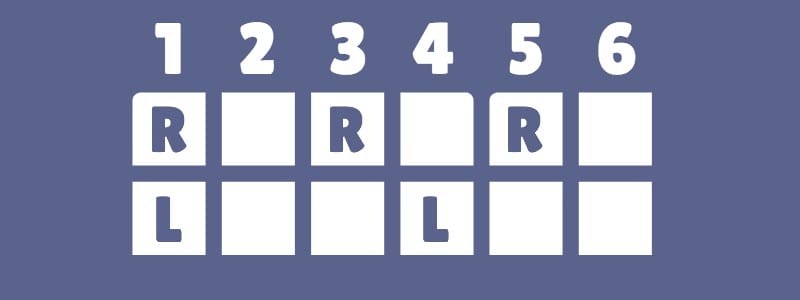
Learn with a Metronome
For beginners, learning polyrhythms by ear with a metronome is an excellent idea. Again, be sure to start slow; set your metronome to 60 beats per minute, taking the time to make sure you are getting every individual note/beat and speeding up as you become more comfortable with the rhythm.
If you’re struggling to play a polyrhythm right off the bat with a simple metronome, try out a polyrhythm metronome, such as PolyNome! It plays each beat of both meters for you to play along to, giving you the opportunity to really internalize the feel of each polyrhythm. Especially wonderful is the app’s Practice Log feature – you can keep track of what rhythms you played at what tempos and for how long, and even have access to charts and reports to track your progress.
Use a Sequencer
Did the grid system for visualizing and counting polyrhythms especially appeal to you? If so, your learning style may be best served with an online sequencer tool.
This tool comes with a plethora of instrument options, and has a highly customizable grid that you can edit to fit nearly any time signature and polyrhythm you can dream of. Best of all, there’s a playback button so you can hear exactly what your polyrhythm sounds like and clap or play along.
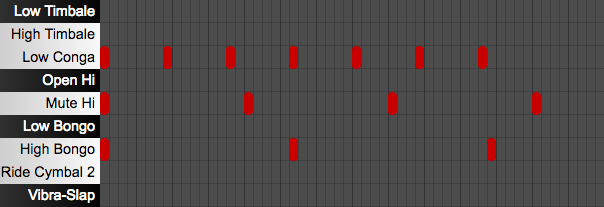 The sequencer is also great for those wanting to experiment with more complex polyrhythms – the boxes representing a hit can be moved around, shortened, or lengthened with just one click.
The sequencer is also great for those wanting to experiment with more complex polyrhythms – the boxes representing a hit can be moved around, shortened, or lengthened with just one click.
Polyrhythms and Melody
Wondering how you can play polyrhythms if you’re a piano player or guitarist?
Try playing a beat on your instrument, whether it’s on one note or a simple melodic motif, while humming, tapping, or clapping overtop in a different rhythm. Start with an easier one such as 3:2.
Once you get better at this, you can lay down a 4/4 beat on a metronome or drum machine, and try playing scales in a different rhythm overtop the beat – for example, a 5:4 pattern.
Mile High Shred’s polyrhythm examples for guitarists illustrate how you can play over drum beats to form your own two-instrument polyrhythms!
Beyond The Basics
Polyrhythms are tricky little beasts that will take some time to really internalize and become comfortable with. Though they may appear intimidatingly complicated at first, remember that polyrhythms are made up of simple rhythms that are already familiar to you. The key is to start practicing simpler polyrhythms with the help of a metronome, and working your way up from there.
The good news: once you’ve nailed the basics, there’s no limit to the rhythmic variation that you can give your music.
You can subdivide one or both of the basic rhythms contained in a polyrhythm even further for another layer of rhythmic complexity. You can switch from 3:2 to 5:4 and back to surprise your listener, signal changes in music by adding a little polyrhythmic motif here and there, and put a rhythmic spin on an otherwise basic 4/4 composition to really make your music stand out out. If you feel you have a good grasp on the basics, check out Time Manipulation’s mini-lesson on some intermediate polyrhythms.
Polyrhythms are all about feel – so don’t be afraid to experiment, get your whole body involved in keeping time, and have fun – there’s no limit to the fascinating rhythms that will emerge!
Before you know it, you’ll be incorporating the polyrhythms you’ve learned into your musical practice, adding variation and interest to the beats of your own songs.
The post Polyrhythms for Beginners appeared first on Musical U.